Understanding how traits are passed down and how genetic information is controlled at the molecular level is key to mastering this chapter. Going through important questions from past exams helps highlight core topics like DNA structure, replication, gene expression, and mutations. These Molecular Basis of Inheritance Class 12 Notes make it easier to focus on concepts that often appear in board exams.
NCERT Class 12 Biology Chapter 6 Notes Molecular Basis of Inheritance
Did you know that your complete genetic code is written using just four bases in DNA? The NCERT Class 12 Biology Chapter 5 Notes Molecular Basis of Inheritance explain all the concepts in simple and easy language to help students understand them better. This chapter covers topics such as the nature of genetic material, experiments proving that DNA is the genetic material, and molecular processes like replication, transcription, and translation. These NCERT Notes help students focus on the most important concepts for board exams as well as competitive exams like NEET.
This Story also Contains
- NCERT Class 12 Biology Chapter 5 Molecular Basis of Inheritance Notes: Download PDF
- Class 12 Biology Chapter 5 Molecular Basis of Inheritance Notes
- Chapter 5 Molecular Basis of Inheritance: Previous Year Question and Answers
- How to Use NCERT Class 12 Biology Chapter 5 Notes Effectively?
- Advantages of Molecular Basis of Inheritance Class 12 Notes
- Chapter-Wise NCERT Class 12 Notes Biology
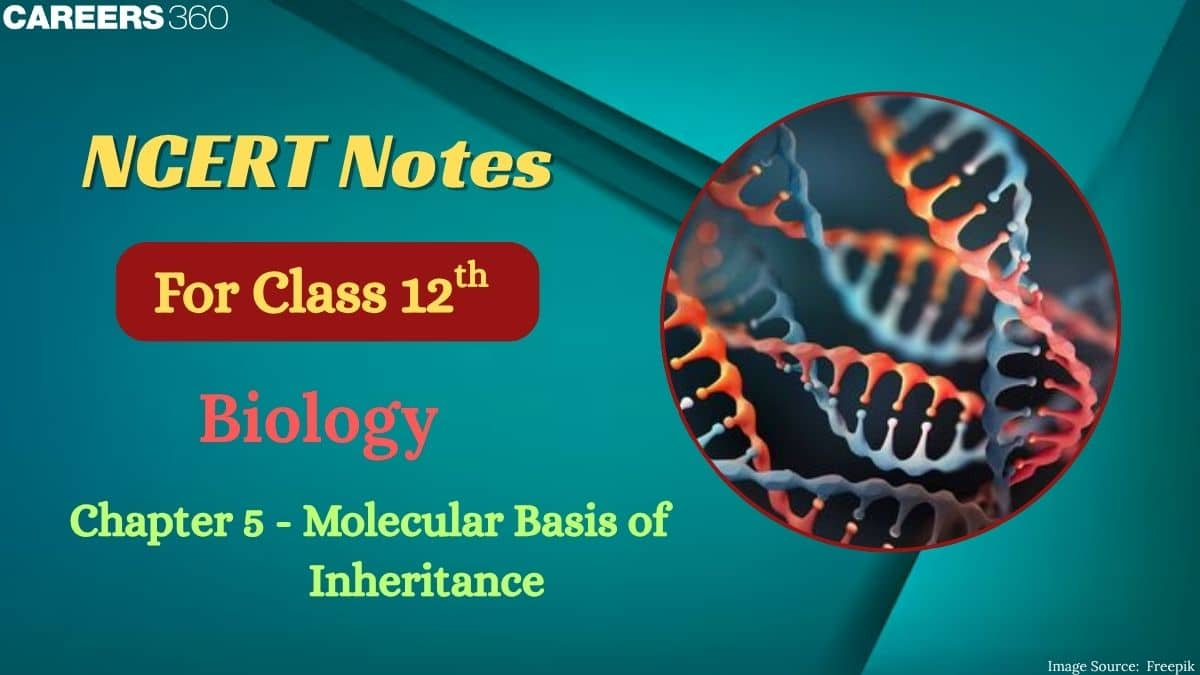
Molecular Basis of Inheritance Class 12 Notes also highlights the two types of nucleic acids found in living systems, which are Deoxyribonucleic acid (DNA) and Ribonucleic acid (RNA). It also explains how the genetic code directs protein synthesis through the processes of transcription and translation. The notes also include some previous year questions to make students familiar with the pattern of questions asked in the exam. These NCERT Notes for Class 12 are a great resource for information and boost knowledge and interest in the subject.
Note: This chapter is renumbered as Chapter 5 in the NCERT Class 12 Biology textbook as per the latest syllabus.
NCERT Class 12 Biology Chapter 5 Molecular Basis of Inheritance Notes: Download PDF
Knowing how genetic information is stored, replicated, and expressed is important for understanding heredity at the molecular level. The NCERT Class 12 Biology Chapter 5 Notes PDF breaks down the detailed concepts in a simple, student-friendly format. Students can easily access the PDF anytime to strengthen their preparation and focus on the key areas likely to appear in board exams. With clear explanations and well-organized content, these NCERT Notes for Class 12 Biology are perfect for quick revision.
Also check:
Class 12 Biology Chapter 5 Molecular Basis of Inheritance Notes
In the Molecular Basis of Inheritance chapter, students will study that DNA acts as genetic material in most organisms, whereas RNA acts as genetic material in some viruses. RNA mostly functions as a messenger. Through the NCERT Class 12 Biology Chapter 5 notes, they will also study that RNA has other functions as an adapter, structural, or as a catalytic molecule. All the NCERT concepts are included in the notes, which are important for board exam preparation.
What is DNA?
DNA, or deoxyribonucleic acid, is a molecule that carries most of the genetic instructions used in the development, functioning, and reproduction of all known living organisms and many viruses. It is a long, double-stranded helical structure located in the cell nucleus of eukaryotic organisms and in the cell's cytoplasm in prokaryotic cells (bacteria and archaea).
As per the central dogma of molecular biology, genetic information flows from DNA to RNA to protein.
The structure of DNA is often described as a double helix, resembling a twisted ladder. Each "rung" of the ladder consists of two nucleotide units, and these nucleotides are the building blocks of DNA. Each nucleotide is composed of a sugar molecule (deoxyribose), a phosphate group, and one of four nitrogenous bases: adenine (A), thymine (T), cytosine (C), and guanine (G).
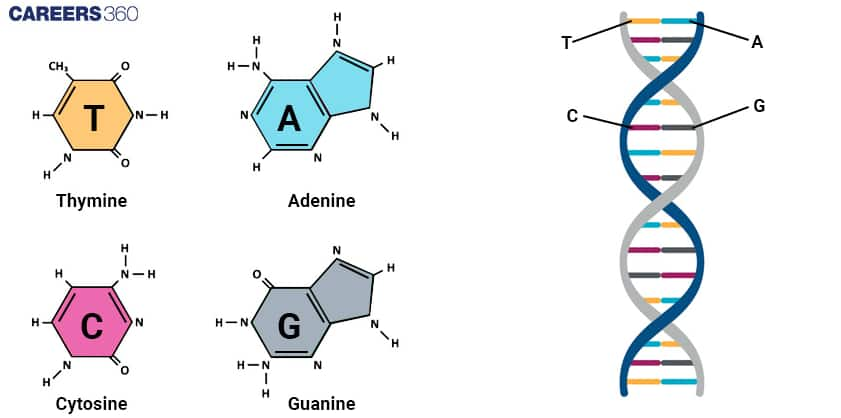
Structure of Polynucleotide Chain
(i) A nucleotide has three parts, i.e., a nitrogenous base, a pentose sugar (deoxyribose in DNA and ribose in RNA), and a phosphate group.
(ii) Nitrogenous bases are purines, i.e,. adenine, guanine, and pyrimidines, i.e,. cytosine, uracil, and thymine.
(iii) Cytosine is common to both DNA and RNA, and thymine is present in DNA. Uracil is present in RNA at the place of thymine.
(iv) A nitrogenous base is linked to the pentose sugar through an N-glycosidic linkage to form a nucleoside, i.e., adenosine and guanosine, etc.
(v) When a phosphate group is linked to the 5′ —OH of a nucleoside through phosphodiester linkage, a corresponding nucleotide is formed.
(vi) Two nucleotides are linked through 3′ -> 5′ phosphodiester linkage to form a dinucleotide.
(vii) Several nucleotides can be joined to form a polynucleotide chain.
In the case of RNA, every nucleotide residue has an additional—OH group present at the 2-position in the ribose. Also, the uracil is found at the place of thymine (5-methyl uracil).
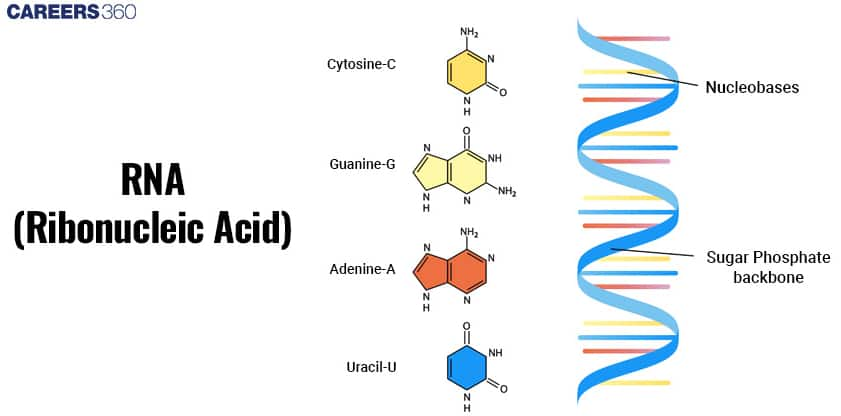
Discoveries Related to the Structure of DNA
(i) Friedrich Miescher in 1869, first identified DNA as an acidic substance present in the nucleus and named it ‘nuclein’.
(ii) James Watson and Francis Crick proposed a very simple double helix model of DNA in 1953, based on X-ray diffraction data.
(iii) Erwin Chargaff proposed that for a double-stranded DNA, the ratios between adenine and thymine and guanine and cytosine are constant and equal to one.
Salient Features of the Double-helix Structure of DNA
(i) DNA is a long polymer of deoxyribonucleotides. It is made up of two polynucleotide chains, where the backbone is constituted by sugar-phosphate and the bases project inside.
(ii) Two chains have anti-parallel polarity, i.e., 5′ > 3′ for one, 3′ > 5′ for another.
(iii) The bases in two strands are paired through hydrogen bonds (H-bonds), forming base pairs (bp). Adenine forms two hydrogen bonds with thymine from the opposite strand and vice versa. Guanine bonds with cytosine by three H-bonds. Due to this, purine always comes opposite to pyrimidine. This forms a uniform distance between the two strands.
(v) The plane of one base pair stacks over the other in the double helix. This confers stability to the helical structure in addition to H-bonds. The length of a DNA double helix is about 2.2 meters. Therefore, it needs special packaging in a cell.
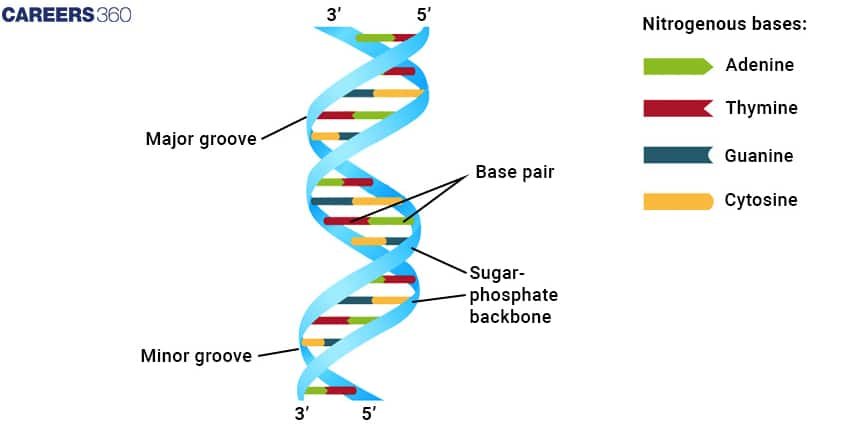
Histones
- They are organized to form a unit of eight molecules called a histone octamer. The negatively charged DNA is wrapped around the positively charged histone octamer to form a structure called a nucleosome. A typical nucleosome contains 200 bp of DNA helix.
- Nucleosomes constitute the repeating unit of a structure in the nucleus called chromatin (a thread-like stained structure). Under an electron microscope, the nucleosomes in chromatin can be seen as beads-on-string. This structure in chromatin is packaged to form chromatin fibres that further coil and condense to form chromosomes at the metaphase stage.
- The packaging of chromatin at a higher level requires an additional set of proteins, which are collectively called Non-Histone Chromosomal (NHC) proteins.
- In a nucleus, some regions of chromatin are loosely packed (stain lightly) and are called euchromatin (transcriptionally active chromatin). In some regions, chromatin is densely packed (stains dark) and is called heterochromatin (inactive chromatin).
DNA is the Genetic Material
Hershey and Chase's experiment (1952) gave unequivocal proof that DNA is the genetic material.
- In these experiments, bacteriophages (viruses that infect bacteria) were used. They grew some viruses on a medium that contained radioactive phosphorus and some others on a medium containing radioactive sulphur.
- Radioactive phages were allowed to attach to E. coli bacteria. As the infection proceeded, viral coats were removed from the bacteria by agitating them in a blender. The virus particles were separated from the bacteria by spinning them in a centrifuge.
- Bacteria that were infected with viruses that had radioactive DNA were radioactive, indicating that DNA was the material that passed from the virus to the bacteria, and bacteria that were infected with viruses that had radioactive proteins were not radioactive. This indicated that the proteins did not enter the bacteria from viruses.
Hence, it proved that DNA is a genetic material that is passed from virus to bacteria.
Properties of Genetic Material
Properties of Genetic Material are given below:
(i) It became established that DNA is the genetic material from the Hershey-Chase experiment.
(ii) In some viruses, RNA was also reported as genetic material, e.g., Tobacco mosaic viruses, QB bacteriophage, etc.
(iii) Characteristics of a Genetic Material
(a) It should be able to replicate.
(b) It should be chemically and structurally stable.
(c) It should provide scope for slow changes (mutation) that are required for evolution.
(d) It should be able to express itself in the form of ‘Mendelian characters’.
(iv) According to the above-mentioned rules, both the nucleic acids (DNA and RNA) can direct duplications.
Stability can be explained in DNA as the two strands being complementary; if separated by heating, they come together in appropriate conditions.
Central Dogma
Francis Crick proposed the central dogma of molecular biology, which states that the genetic information flows from DNA to RNA to protein.
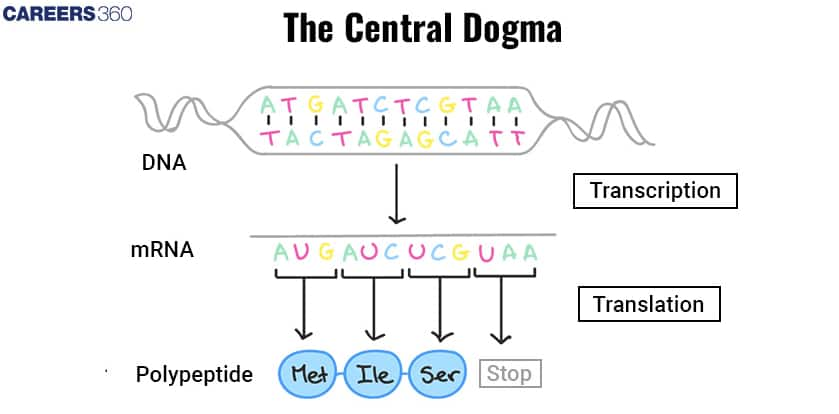
Replication Of DNA
DNA replication was proposed by Watson and Crick (1953) and termed semiconservative. According to Them:
(i) The two strands would separate and act as a template for the synthesis of new complementary strands.
(ii) After replication, each DNA molecule would have one parental and one newly synthesized strand.
(iii) Replication in the DNA strand occurs within a small opening of the DNA helix, known as the replication fork.
Meselson and Stahl's experimental proof says that DNA replicates semi-conservatively, comes first from E. coli and later from higher organisms, such as plants and human cells. They performed this in 1958.
- E. coli was grown in a medium containing 15NH4Cl as the only nitrogen source for many generations. 15N got incorporated into newly synthesized DNA (and other nitrogen-containing compounds). This heavy DNA molecule could be distinguished from the normal DNA by centrifugation in a cesium chloride (CsCl) density gradient.
- The researchers then transferred the cells into a medium containing 14NH4Cl, took samples at various intervals as the cells multiplied, and extracted the DNA that remained as double-stranded helices. DNA samples were separated independently on CsCl gradients to measure DNA densities.
- DNA that was extracted from the culture, one generation (after 20 min) after the transfer from 15N to 14N medium, had a hybrid or intermediate density. DNA extracted from the culture after another generation (after 40 min) was composed of equal amounts of this hybrid DNA and of light DNA.
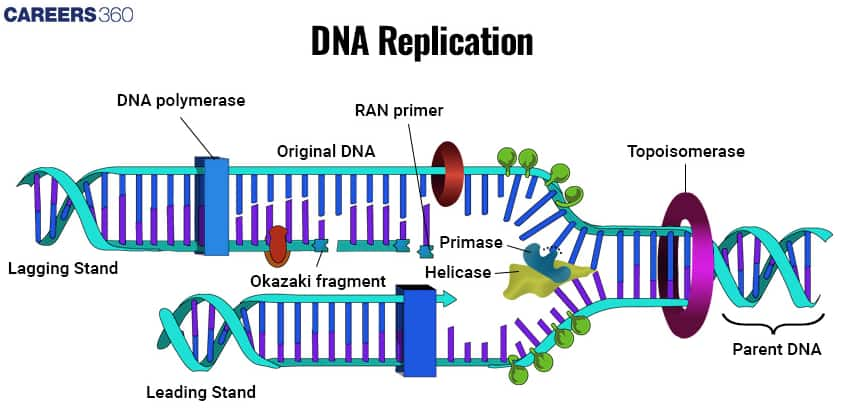
Origin of Replication
DNA polymerases cannot initiate the process of replication on their own. Also, replication does not initiate randomly at any place in DNA. So, there is a definite region in E.coli DNA where the replication originates. The region is termed the origin of replication.
There are the following three types of RNAs:
(i) mRNA (messenger RNA) provides the template for transcription.
(ii) tRNA (transfer RNA) brings amino acids and reads the genetic code.
(iii) rRNA (ribosomal RNA) plays a structural and catalytic role during translation.
All three RNAs are needed to do the process of protein synthesis in a cell.
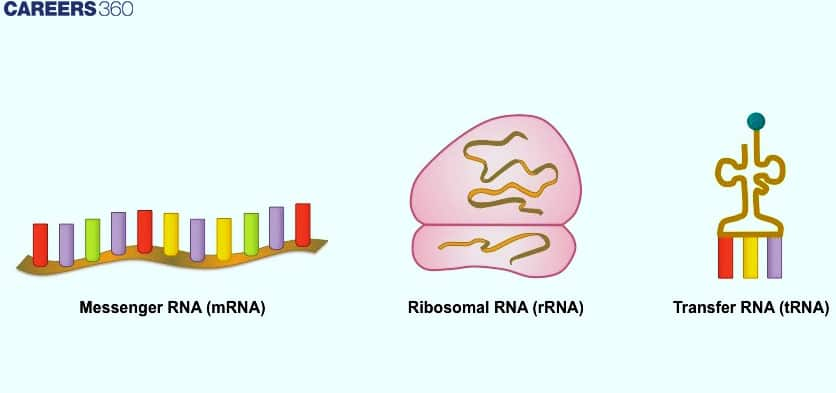
Transcription
In transcription, only a segment of DNA is duplicated, and on one of the strands, it is copied into RNA. Neither of the strands is copied because of these reasons:
• If both the strands code for RNA, two different RNA molecules and two different proteins would be formed, hence complicating the genetic information transfer machinery.
• Since two RNAs produced would be complementary to each other, they would form a double-stranded RNA without translation, making the process of transcription futile.
A transcription unit in DNA is defined by three regions in the DNA, which are as follows:
A promoter
The structural gene
A terminator
Transcription Unit and the Gene
A gene can be defined as the functional unit of inheritance.
A cistron is a segment of DNA coding for a polypeptide.
The structural gene in a transcription unit could be said as monocistronic (mostly in eukaryotic cells) or polycistronic (mostly in bacteria or prokaryotes).
The coding sequences or expressed sequences are defined as exons. Exons appear in mature or processed RNA. The exons are interrupted by introns.
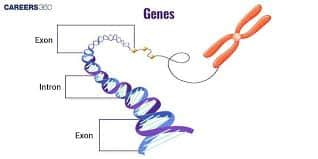
Introns or intervening sequences do not appear in mature or processed RNA.
Transcription in Prokaryotes
Transcription in prokaryotes occurs in the following steps:
A single DNA-dependent RNA polymerase catalyzes the transcription of all types of RNA in bacteria.
RNA polymerase binds to the promoter and initiates transcription (initiation).
It uses nucleoside triphosphates as substrate and polymerizes in a template-dependent fashion following the rule of complementarity.
It also facilitates the opening of the helix and continues elongation.
Once the polymerase reaches the terminator region, the nascent RNA falls off, and so does the RNA polymerase. This results in the termination of transcription.
RNA polymerase is only capable of catalyzing the process of elongation.
It associates transiently with the initiation factor
(a) and the terminator factor
(b) to initiate and terminate the transcription, respectively. Thus, catalyzing all three steps.
Since the mRNA does not require any processing to become active and also since transcription and translation take place in the same compartment, often the translation can begin much before the mRNA is fully transcribed. As a result, transcription and translation can be coupled in bacteria.
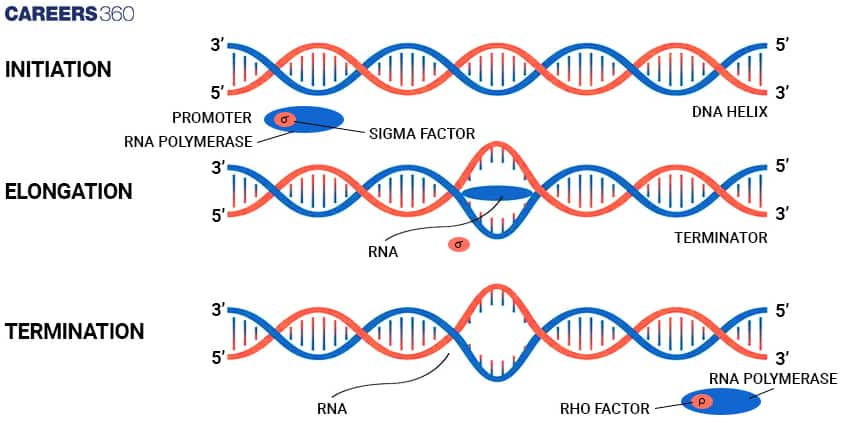
Process of Transcription in Eukaryotes
The Significance of these complexities is:
(i) The split gene arrangements represent an ancient feature of the genome.
(ii) The presence of introns is reminiscent of antiquity.
(iii) The process of splicing represents the dominance of the RNA world
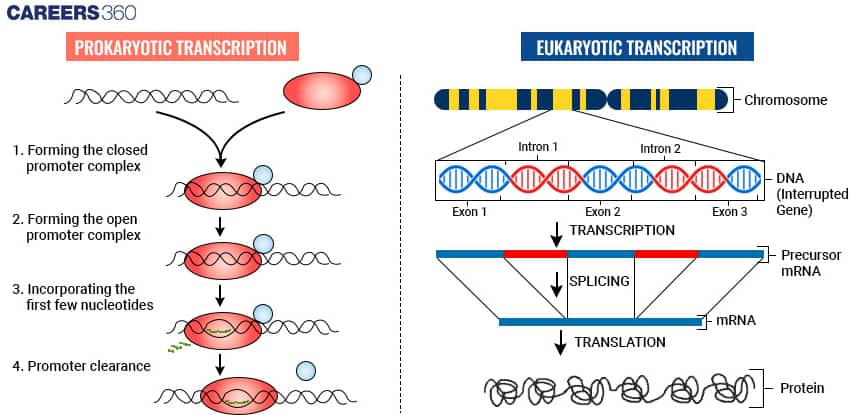
Also, Read
Chapter 5 Molecular Basis of Inheritance: Previous Year Question and Answers
Question 1. Hind II always cuts DNA molecules at a particular point called a recognition sequence, and it consists of:
Option 1. 8 bp
Option 2. 6 bp
Option 3. 4 bp
Option 4. 10 bp
Answer :
The first restriction endonuclease – Hind II, whose functioning depends on a specific DNA nucleotide sequence, was isolated. It was found that Hind II always cut DNA molecules at a particular point by recognizing a sequence of six base pairs. Options (1), (3), and (4) are incorrect because they have either more than 6 or fewer than 6 bp.
Hence, the correct answer is option (2), 6 bp
Question 2. Which of the following best sums up the characteristics of genetic material?
Option 1. Genetic material must possess the capacity for replication, be chemically and structurally stable, and manifest Mendelian traits.
Option 2. Genetic material needs to be highly mutagenic, chemically reactive, and capable of replication.
Option 3. Genetic material must possess the capacity for gradual alterations, replication, and molecular-directed polymerization.
Option 4. Genetic material must be able to display Mendelian traits, be chemically and physically stable, and prefer RNA over DNA for storing information.
Answer :
For genetic material to work effectively, it needs to have several important properties:
Ability to Duplicate: Genetic substance should be able to duplicate itself very accurately at cell division.
Chemical and structural stability. It should be stable and not mutated or degraded.
Mendelian Character Expression: It should show Mendel's pattern of inheritance in which traits can be transmitted from one generation to the next.
Hence, the correct answer is option (1). Genetic material must possess the capacity for replication, be chemically and structurally stable, and manifest Mendelian traits.
Question 3. The genetic material must possess the property of stability to ensure:
Option 1. Accurate DNA replication
Option 2. Genetic variation
Option 3. Mutations
Option 4. Gene expression
Answer :
For genetic information to be passed on correctly from one generation to the next, the genetic material must be stable. This stability ensures that the DNA sequence remains unchanged during replication, allowing cells to produce exact copies. Without stability, errors would occur frequently, disrupting inheritance and cellular functions.
Hence, the correct answer is option (1). Accurate DNA Replication.
Question 4. Which of the following enzymes is responsible for joining Okazaki fragments during DNA replication?
Option 1. DNA helicase
Option 2. DNA polymerase I
Option 3. DNA ligase
Option 4. RNA primase
Answer :
During DNA replication, Okazaki fragments are formed on the lagging strand. DNA ligase joins these fragments by forming phosphodiester bonds, creating a continuous DNA strand. Without DNA ligase, replication would remain incomplete.
Hence, the correct answer is option (3), DNA ligase.
Question 5. Which nitrogenous base is absent in RNA?
Option 1. Adenine
Option 2. Guanine
Option 3. Cytosine
Option 4. Thymine
Answer :
RNA contains adenine, guanine, cytosine, and uracil. Thymine is found only in DNA and is replaced by uracil in RNA. This difference helps distinguish DNA from RNA at the molecular level.
Hence, the correct answer is option (4), Thymine.
Also Read:
How to Use NCERT Class 12 Biology Chapter 5 Notes Effectively?
Every living thing passes on information from one generation to the next. This is how traits like eye color, height, or even certain diseases run in families. But how does the body store and use this information? Students can understand this by using these notes.
Learn how scientists discovered that DNA, not proteins, carries genetic information through the Class 12 Biology Chapter 5 Molecular Basis of Inheritance Notes.
Understand the structure of DNA and how it makes copies of itself during cell division.
Explore how the body reads DNA instructions to make proteins through transcription and translation through the diagrams and flow charts.
Know how certain genes are turned on or off depending on what the cell needs, which are highlighted in the notes.
See how small changes in DNA, called mutations, can lead to differences in traits or even genetic disorders by using the Class 12 Biology Chapter 5 Molecular Basis of Inheritance Notes.
Advantages of Molecular Basis of Inheritance Class 12 Notes
The Molecular Basis of Inheritance chapter explains how genetic information is stored, expressed, and transmitted at the molecular level. These notes help students clearly understand DNA, RNA, and gene regulation concepts that are frequently asked in exams.
Class 12 Biology Chapter 5 Molecular Basis of Inheritance Notes PDF helps in understanding the structure and function of DNA and RNA clearly.
The notes also explain the process of replication, transcription, and translation in a simplified manner.
Difficult concepts like mutations, genetic code, and gene expression are easy to understand by going through the notes.
The notes include well-labelled diagrams which allow students to answer diagram and application-based questions easily in board exams.
Class 12 Biology Chapter 5 Molecular Basis of Inheritance Notes PDF strengthens the conceptual foundation for competitive exams like NEET.
Chapter-Wise NCERT Class 12 Notes Biology
This table provides concise notes for every chapter in Class 12 Biology. Each topic is explained simply and clearly, making it easier for students to revise efficiently and understand concepts quickly.
| NCERT Class 12 Biology Chapter 1 Sexual Reproduction in Flowering Plants Notes |
| NCERT Class 12 Biology Chapter 2 Human Reproduction Notes |
| NCERT Class 12 Biology Chapter 3 Reproductive Health Notes |
| NCERT Class 12 Biology Chapter 4 Principles of Inheritance and Variation Notes |
| NCERT Class 12 Biology Chapter 5 Molecular Basis of Inheritance Notes |
| NCERT Class 12 Biology Chapter 6 Evolution Notes |
| NCERT Class 12 Biology Chapter 7 Human Health and Disease Notes |
| NCERT Class 12 Biology Chapter 8 Microbes in Human Welfare Notes |
| NCERT Class 12 Biology Chapter 9 Biotechnology: Principles and Processes Notes |
| NCERT Class 12 Biology Chapter 10 Biotechnology and its Applications Notes |
| NCERT Class 12 Biology Chapter 11 Organisms and Populations Notes |
| NCERT Class 12 Biology Chapter 12 Ecosystem Notes |
| NCERT Class 12 Biology Chapter 13 Biodiversity and Conservation Notes |
Frequently Asked Questions (FAQs)
A DNA helix is a twisted ladder-like structure composed of two long strands of nucleotides. These strands are held together by hydrogen bonds between complementary pairs of nitrogenous bases (adenine with thymine, and cytosine with guanine), forming the double-stranded structure of DNA.
Gene expression regulation refers to the control of the synthesis of proteins or functional RNA molecules from a gene. It involves a complex interplay of various molecular mechanisms that can enhance or suppress the transcription and translation processes, ultimately influencing the level of gene activity within a cell.
DNA replication is semi-conservative because each newly synthesized DNA molecule contains one strand from the parent template DNA and one newly synthesized complementary strand.
During replication, the DNA double helix unwinds, and each separated strand serves as a template for the synthesis of a new strand. This process ensures that genetic information is accurately passed on to the next generation, with each newly replicated DNA molecule conserving one "old" strand and one newly synthesized strand.
The NCERT Class 12 Biology Chapter 5 Notes Molecular Basis of Inheritance simplify complex topics like DNA replication, gene expression, and mutations, making it easier to understand and revise. They highlight key points often asked in board exams and help students save time by providing clear, structured summaries of each concept.
This chapter holds significant weight in the Biology syllabus and frequently appears in both objective and long-answer sections of the exam. Understanding the molecular basis of inheritance is also essential for competitive exams like NEET, making it one of the most crucial chapters to study thoroughly.
Courses After 12th
Applications for Admissions are open.
As per latest syllabus. Physics formulas, equations, & laws of class 11 & 12th chapters
JEE Main Important Chemistry formulas
Get nowAs per latest syllabus. Chemistry formulas, equations, & laws of class 11 & 12th chapters
JEE Main high scoring chapters and topics
Get nowAs per latest 2024 syllabus. Study 40% syllabus and score upto 100% marks in JEE
JEE Main Important Mathematics Formulas
Get nowAs per latest syllabus. Maths formulas, equations, & theorems of class 11 & 12th chapters
